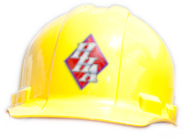It's not that hard really, at least in principle. You want to reduce the air leakage in your home so you keep the conditioned air inside and the cold air outside this winter. What's the advice of all those stories that are so plentiful in the media this time of year? Caulk your windows and weatherstrip your doors. Every year it's the same story. And every year it's misguided.
If you really want to reduce your air leakage, follow these three rules of air sealing.
Rule #1: Seal the big holes first
To make a big difference in a hurry, find the big holes. Hint: it's not the windows and doors. Mostly they're in ceilings below unconditioned attics and floors over unconditioned crawl spaces and basements. Here's what some look like.
Mechanical chases—or whole rooms in this case—that aren't sealed at the top. The photo above is from a 40 year old condo with tremendous air leakage.
Bathtub drain holes are often the largest holes in a home.
Other big holes include strange things like the refrigerator vent a contractor cut in my inlaws' ceiling and attic knee walls with no sheathing on either side, which occurs where bathtubs are next to a knee wall. If your house isn't completely intact, you can have a lot of air leakage, too. My condo was missing about half of the laundry room ceiling for a while because of a water leak from our neighbors upstairs. When we had it repaired, we dropped the air leakage by nearly 40%.
Rule #2: Seal the medium-sized holes second
Stands to reason, doesn't it? You want to get the biggest bang for your buck, so go for the holes in order of size.
The medium-sized air leakage hole shown here is where a furnace flue goes from the basement through the first floor on its way to the attic. See that fluffy yellow and black stuff? That's a clue that tells you two things. It's blown fiberglass insulation. How'd it get there? It fell from the attic, so the hole where the flue goes into the attic isn't sealed either. Why is part of the insulation black? Because a lot of air has been moving through that hole and carrying dirt with it.
Caution: When sealing around metal flues, do NOT use flammable materials. Fill the big part of the hole with metal or other noncombustible material and use fire-rated caulk for the remainder of the sealing here.
Rule #3: Seal the small holes last
When you've done all the big and medium-sized holes you can get to, it's time to tackle the small holes.
If you live in an older house, you'll probably find a lot of small holes where electrical wires go from attics, crawl spaces, and basements into the framing, as shown above. Fill those holes with caulk or spray foam. It's generally not a problem in newer homes because fire codes have required this type of sealing for a while.
Other small holes would include things like gaps and cracks around windows and doors. So that advice that the media like to give this time of year is OK, as long as you've already sealed the big and medium-sized holes.
You might still want to hire a home energy pro
If you're a homeowner who likes DIY projects, you could tackle sealing these holes. Here's why you might want to hire a home energy pro anyway. They can:
- Measure the initial air leakage with a Blower Door. This tells you what you're starting point is. It can also find leaks that may have gone unnoticed.
- Find combustion safety issues. If you have combustion appliances, air sealing could result in backdrafting that poisons you and your family with carbon monoxide. Make sure that your home is safe by hiring a pro to test your home for combustion safety. This one shouldn't be optional.
- Find funky building envelope problems. In some homes, air sealing the holes I've discussed in this article may have little to no effect. If your home has hidden connections to unconditioned spaces like garages and basements, those leakage paths may overwhelm your air sealing efforts.
- Measure the final air leakage with a Blower Door. This tells you how much improvement you made.
There's a lot more to this business of air sealing than caulking your windows and weatherstripping your doors.
Source https://www.energyvanguard.com/blog/56102/The-3-Rules-of-Air-Sealing


